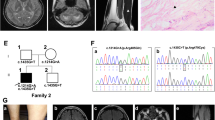Abstract
Cerebrotendinous xanthomatosis (CTX) is a rare autosomal recessive disease due to defective activity of the mitochondrial enzyme sterol 27-hydroxylase. In 1991, sterol 27-hydroxylase gene (CYP27A1) was localised on the long arm of chromosome 2 [1]. Clinical characteristics of CTX are diarrhoea, cataracts, tendon xanthomas and neurological manifestations including dementia, psychiatric disturbances, pyramidal and/or cerebellar signs, and seizures. More than 300 patients with CTX have been reported to date worldwide and about 50 different mutations identified in the CYP27A1 gene. Almost all mutations lead to the absence or inactive form of the sterol 27-hydroxylase. In this review, according with the aims of this section of the journal, we describe the different pathogenetic mutations in the CYP27A1 gene and the main clinical and pathogenetic aspects that may help clinical neurologists in the diagnosis of CTX.
Similar content being viewed by others
Author information
Authors and Affiliations
Corresponding author
Rights and permissions
About this article
Cite this article
Gallus, G.N., Dotti, M.T. & Federico, A. Clinical and molecular diagnosis of cerebrotendinous xanthomatosis with a review of the mutations in the CYP27A1 gene. Neurol Sci 27, 143–149 (2006). https://doi.org/10.1007/s10072-006-0618-7
Received:
Accepted:
Issue Date:
DOI: https://doi.org/10.1007/s10072-006-0618-7




